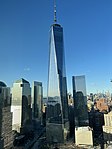Verizon Building

The Verizon Building (also known as 100 Barclay, the Barclay–Vesey Building, and the New York Telephone Company Building) is an office and residential building at 140 West Street in Lower Manhattan, New York City. The 32-story building was designed in the Art Deco style by Ralph Walker of Voorhees, Gmelin and Walker, and was Walker's first major commission as well as one of the first Art Deco skyscrapers. It occupies the entire block bounded by West Street to the west, Barclay Street to the north, Vesey Street to the south, and Washington Street to the east, abutting the World Trade Center. The Verizon Building was constructed from 1923 to 1927 as the Barclay–Vesey Building. It served as the longtime corporate headquarters of New York Telephone and its successor Verizon Communications. The building, being adjacent to the original World Trade Center to the south and 7 World Trade Center to the east, experienced major damage in the September 11 attacks following the collapse of the World Trade Center. Restoration of the building and damaged communications infrastructure after the attacks took three years and cost $1.4 billion. Part of the building was converted into 100 Barclay, a residential condominium development, in 2016. The Verizon Building's architects intended for the structure to have an imposing form, with vertical piers designed as buttresses; setbacks at upper floors; and a program of elaborate ornamentation on the exterior and interior. The Verizon Building's design has been widely praised by architectural critics, both for its design scheme and for its symbolism. The building was added to the National Register of Historic Places in 2009, and its exterior and first-floor interior were declared city landmarks by the New York City Landmarks Preservation Commission in 1991.
Excerpt from the Wikipedia article Verizon Building (License: CC BY-SA 3.0, Authors, Images).Verizon Building
West Street, New York Manhattan
Geographical coordinates (GPS) Address External links Nearby Places Show on map
Geographical coordinates (GPS)
| Latitude | Longitude |
|---|---|
| N 40.713888888889 ° | E -74.013055555556 ° |
Address
Verizon Building
West Street 140
10007 New York, Manhattan
New York, United States
Open on Google Maps





